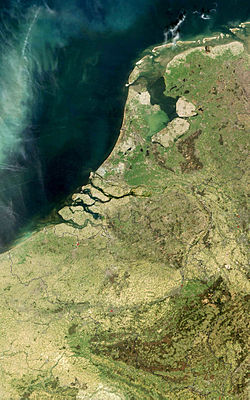
Back Lae Lande Afrikaans البلدان المنخفضة Arabic Гістарычныя Нідэрланды Byelorussian Нидерландия (историческа област) Bulgarian Països Baixos (regió històrica) Catalan Nizozemí (region) Czech Y Gwledydd Isel Welsh Nederlandene (historisk område) Danish Netherlands DAG Κάτω Χώρες (περιοχή) Greek

The European region known as the Low Countries (Dutch: de Lage Landen; French: les Pays-Bas), historically also known as the Netherlands (Dutch: de Nederlanden) or Belgica, is a coastal lowland region in Northwestern Europe forming the lower basin of the Rhine–Meuse–Scheldt delta and consisting today of the three modern "Benelux" countries: Belgium, Luxembourg, and the Netherlands – which English and French give the same name as the traditional regional name. Geographically and historically, the area also includes parts of France and Germany such as French Flanders and the German regions of East Frisia and Cleves. During the Middle Ages, the Low Countries were divided into numerous semi-independent principalities.[1][2]
Historically, the regions without access to the sea linked themselves politically and economically to those with access to form various unions of ports and hinterland,[3] stretching inland as far as parts of the German Rhineland. Because of this, nowadays not only physically low-altitude areas, but also some hilly or elevated regions are considered part of the Low Countries, including Luxembourg and the south of Belgium. Within the European Union, the region's political grouping is still referred to as the Benelux (short for Belgium-Netherlands-Luxembourg).
During the Roman Empire, the region contained a militarised frontier and contact point between Rome and Germanic tribes.[4] With the fall of the Western Roman Empire, the Low Countries were the scene of the early independent trading centres that marked the reawakening of Europe in the 12th century. In that period, they rivalled northern Italy as one of the most densely populated regions of Western Europe. Guilds and councils governed most of the cities along with a figurehead ruler; interaction with their ruler was regulated by a strict set of rules describing what the latter could and could not expect. All of the regions mainly depended on trade, manufacturing and the encouragement of the free flow of goods and craftsmen.[5] Dutch and French dialects were the main languages used in secular city life.
- ^ "Low Countries". Encyclopædia Britannica. Encyclopædia Britannica, Inc. Retrieved 26 January 2014.
- ^ "Low Countries – definition of Low Countries by the Free Online Dictionary, Thesaurus and Encyclopedia". Farlex, Inc. Retrieved 26 January 2014.
- ^ Matei-Chesnoiu, Monica (2012). Re-imagining Western European Geography in English Renaissance Drama. Palgrave Macmillan. p. 105. ISBN 9780230366305.
- ^ Turner, Barry (2010). The Statesman's Yearbook 2011: The Politics, Cultures and Economies of the World. Springer. p. 908. ISBN 9781349586356.
- ^ Braudel, Fernand (1992). Civilization and Capitalism, 15th–18th Century, Vol. III: The Perspective of the World. University of California Press. p. 98. ISBN 9780520081161.
© MMXXIII Rich X Search. We shall prevail. All rights reserved. Rich X Search


